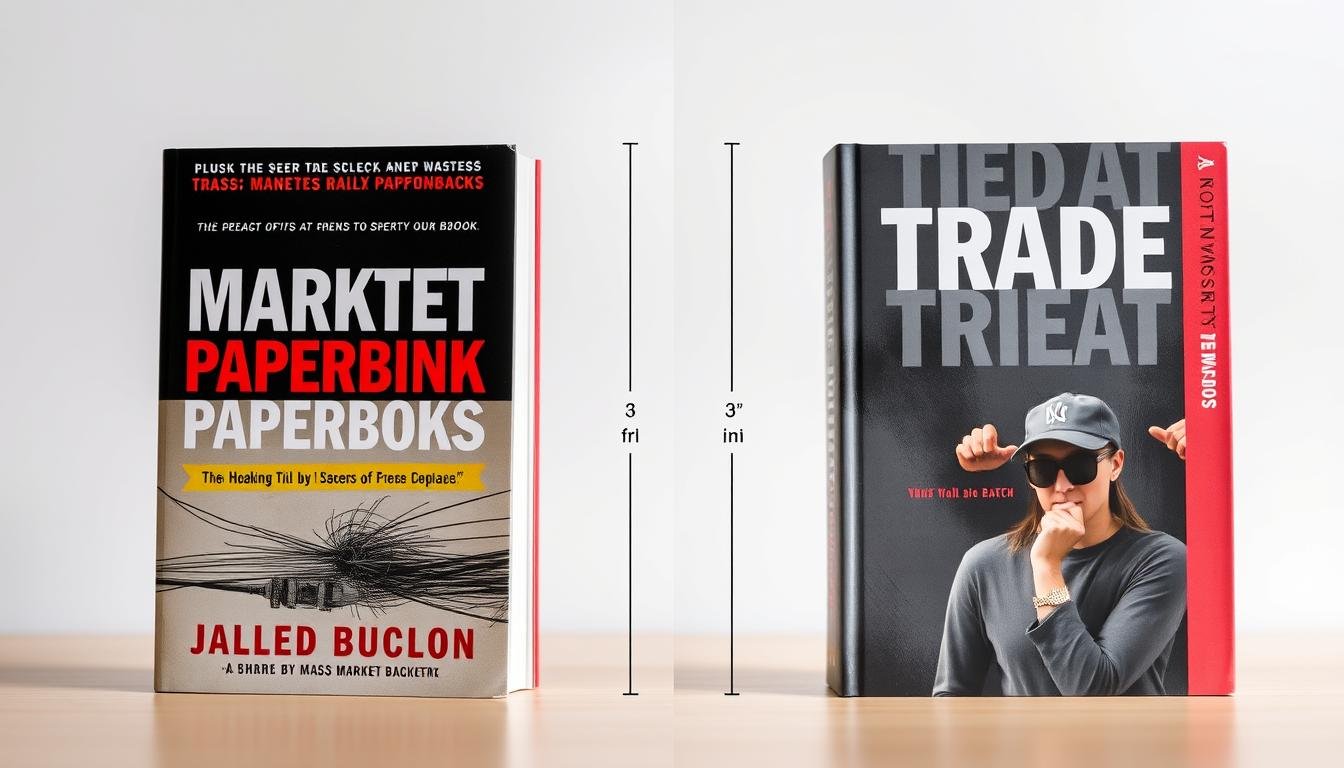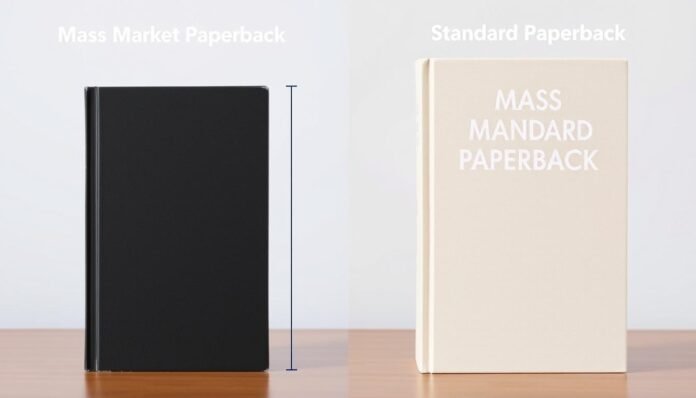A side-by-side comparison of a mass-market paperback and a standard paperback showcasing their distinct sizes and textures. The mass-market paperback is smaller with a glossy cover, while the standard paperback is more prominent with a matte finish. Include details like the spine width, cover art variations, and paper quality differences. Set against a neutral background to emphasize the contrast between the two formats.
Book lovers often see different formats when looking for new reads. Mass market and standard paperbacks are two common types that confuse readers.
These formats share some traits but differ in design and size. They also serve different purposes in the publishing world.
Mass market and standard paperbacks have unique features. Each type meets specific reader needs in different ways.
Knowing about book formats can improve your reading experience and help you choose the best books for your collection.
Understanding Paperback Books
Since the mid-20th century, paperback books have made reading more accessible. They offer an affordable and lightweight alternative to hardcover editions.
Trade paperbacks have better paper and binding than mass-market paperbacks. They wrap a flexible paper cover around the book’s pages.
Publishers use trade paperbacks for academic texts and exceptional non-fiction works. These books are durable yet lightweight.
Trade paperbacks are comfortable to hold and reasonably priced. They measure about 5.5 x 8.5 inches, perfect for easy reading.
The binding techniques make these books last through repeated use. They’re great for students, professionals, and casual readers.
Publishing houses love trade paperbacks for their flexibility. They bridge the gap between expensive hardcovers and compact mass-market editions.
What Are Mass Market Paperbacks?
Mass-market paperbacks changed affordable reading forever. These pocket-sized books made literature accessible to millions of readers.
They’re smaller and more compact than standard paperbacks. Budget-conscious book lovers often choose these affordable options.
Publishers created them in the late 1930s. They saw potential in disposable literature that was easy to carry.
These books cost less to make. They sold for much cheaper prices than hardcover editions.
Mass market paperbacks are usually 4.25 x 6.75 inches. This size is perfect for commuters and travellers.
They use lower-quality paper and cheaper binding. This keeps costs down without ruining the reading experience.
You can find them in many places. Bookstores, drug stores, and supermarkets often sell them.
Their low price made reading available to everyone. People from all backgrounds could enjoy literature easily.
Size and Dimensions: A Comparison
A visually striking comparison of two books side by side, showcasing a mass-market paperback on the left and a trade paperback on the right. Focus on highlighting their differing dimensions, emphasising the size variations in height, width, and thickness. Set against a minimalist background that accentuates the books, featuring a softly lit atmosphere to draw attention to the details of the covers and spines.
Book dimensions affect how readers enjoy their books. Mass market paperbacks are small, measuring 4.25 x 6.87 inches.
Standard paperbacks are more considerable, usually 5.5 x 8.5 to 6 x 9 inches. This size difference impacts how easy books are to carry.
Mass-market paperbacks fit easily in bags and pockets. They’re great for reading while travelling.
Page counts differ between these book types. Mass market paperbacks often have 300-400 pages.
Standard paperbacks can have 250 to 600 pages. Mass-market books have thinner spines and weigh less.
People who want light books love mass-market paperbacks. They’re easy to carry and don’t ruin the reading fun.
Pricing Differences Between Formats
Book pricing varies between mass market and traditional paperbacks. Production costs affect the final retail price.
Mass-market paperbacks are a budget-friendly option for readers. They use cheaper paper and have smaller dimensions.
Traditional paperbacks cost more due to better quality. They have superior print quality and more durable materials.
Retailers price books to appeal to different reader groups. Mass market paperbacks might cost $7.99.
Traditional paperbacks could range from $12.99 to $16.99. These prices reflect production techniques and material quality.
Readers benefit from these diverse pricing options. Mass-market paperbacks are accessible to book lovers.
Premium paperbacks offer a luxurious reading experience. They come at a higher price point.
Target Audience and Distribution
Mass market and traditional paperbacks target different reader groups. Publishers design each format to appeal to specific audiences.
Mass-market paperbacks attract budget-conscious readers. They offer affordable reading options for those looking to save money.
Bookstore placement is key for reaching target readers. Mass market paperbacks often appear in grocery stores and airports.
Traditional paperbacks are found in dedicated bookstore sections. They appeal to book lovers who value quality and presentation.
Online sales have changed book distribution. Digital platforms now show both formats equally.
Amazon and Barnes & Noble websites display these formats. Readers can compare prices and choose their preferred edition.
Reader groups differ between formats. Mass market paperbacks attract commuters and travellers.
Traditional paperbacks appeal to literary fans and collectors. These readers appreciate higher-quality print and design.
Publishers now consider many distribution channels. They balance bookstore placement and online sales.
This strategy helps reach different reader groups. It maximizes the potential audience for each book format.
Conclusion: Choosing the Right Format
Your choice of book format depends on your reading preferences. Collectors enjoy both mass market and standard paperbacks for their unique features.
Mass-market paperbacks are cheap and easy to find. Their small size makes them great for travel and commuting.
Standard paperbacks offer better quality paper and more oversized print. They give a more premium reading experience.
Physical books are still important to many readers. Your choice should match your reading habits and space.
Consider how easy it is to read and carry books and how long they last.
Both formats have their good points. Pick the one that fits your style best.
FAQ
What’s the main difference between mass-market paperbacks and regular paperbacks?
Mass market paperbacks are smaller and cheaper. They measure 4.25 x 6.75 inches with lower-quality materials.
Regular paperbacks are more extensive at 5.5 x 8.5 inches. They have better paper and more durable construction.
Why are mass-market paperbacks so much cheaper?
Mass-market paperbacks use cheaper materials and binding techniques. They’re made for high-volume production and wide distribution.
Are mass-market paperbacks less durable than regular paperbacks?
Yes, mass-market paperbacks wear out faster. They have lower-quality paper and binding.
Trade paperbacks use more substantial materials. They’re built to last longer.
Where are mass-market paperbacks typically sold?
You’ll find mass-market paperbacks in grocery stores and drug stores. They’re also sold in airport shops and newsstands.
Which format is better for collectors?
Collectors prefer trade paperbacks for their higher quality. Mass market paperbacks are seen as less valuable for collecting.
Do authors prefer one format over the other?
Authors like both formats for different reasons. Mass market paperbacks reach more readers at lower prices.
Trade paperbacks offer a better reading experience and higher royalties.
How do digital books impact these traditional paperback formats?
Digital books challenge traditional publishing, but paperbacks still thrive. Many readers prefer physical books, especially for specific genres.
Can I tell the difference between formats just by looking?
Yes, size is the main difference. Mass market paperbacks are smaller and more compact.
Trade paperbacks are more extensive and look more substantial.
you may also read : Five Marketing Strategies That Retailers Spend Half of Their Annual Budget On
